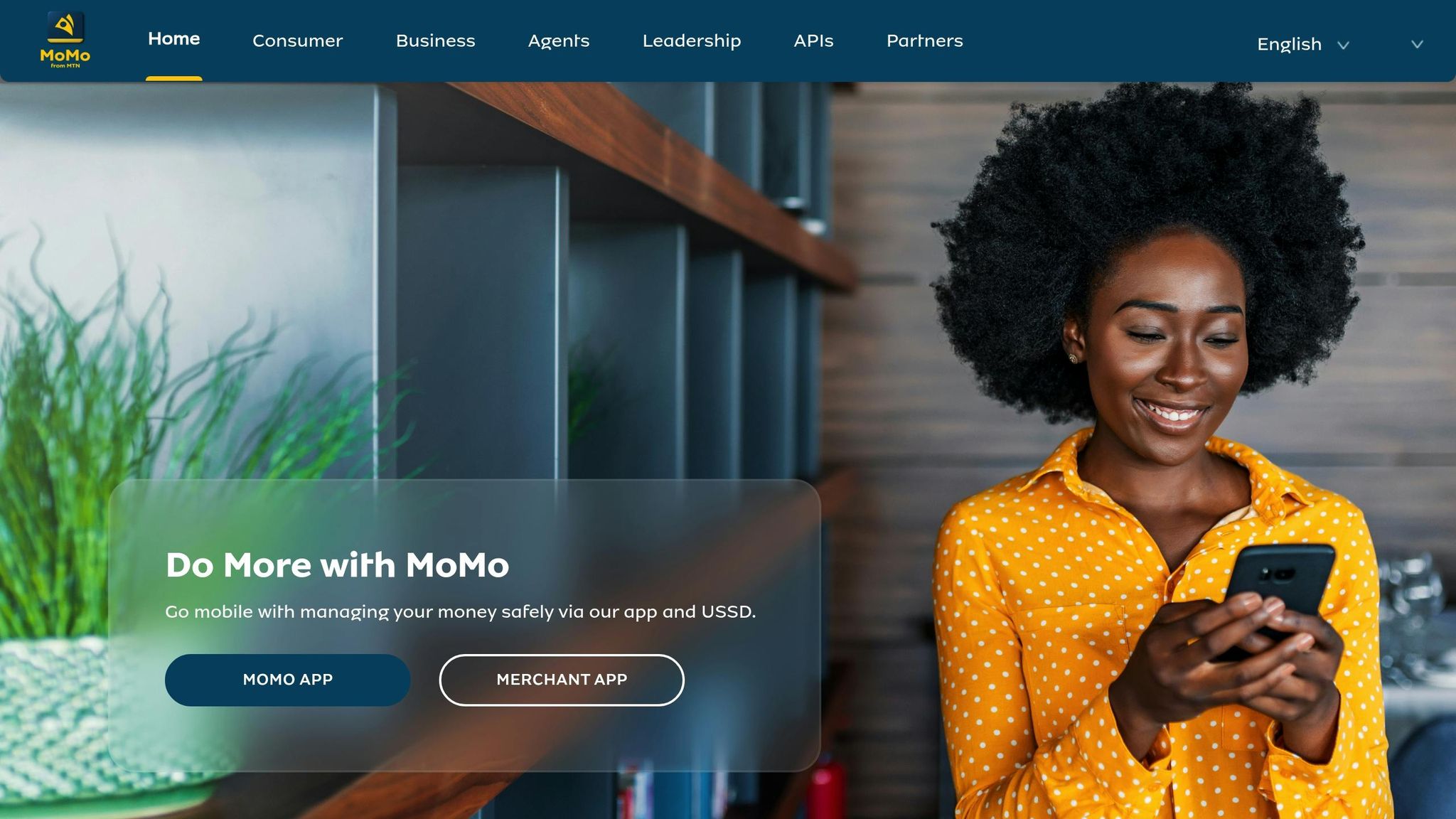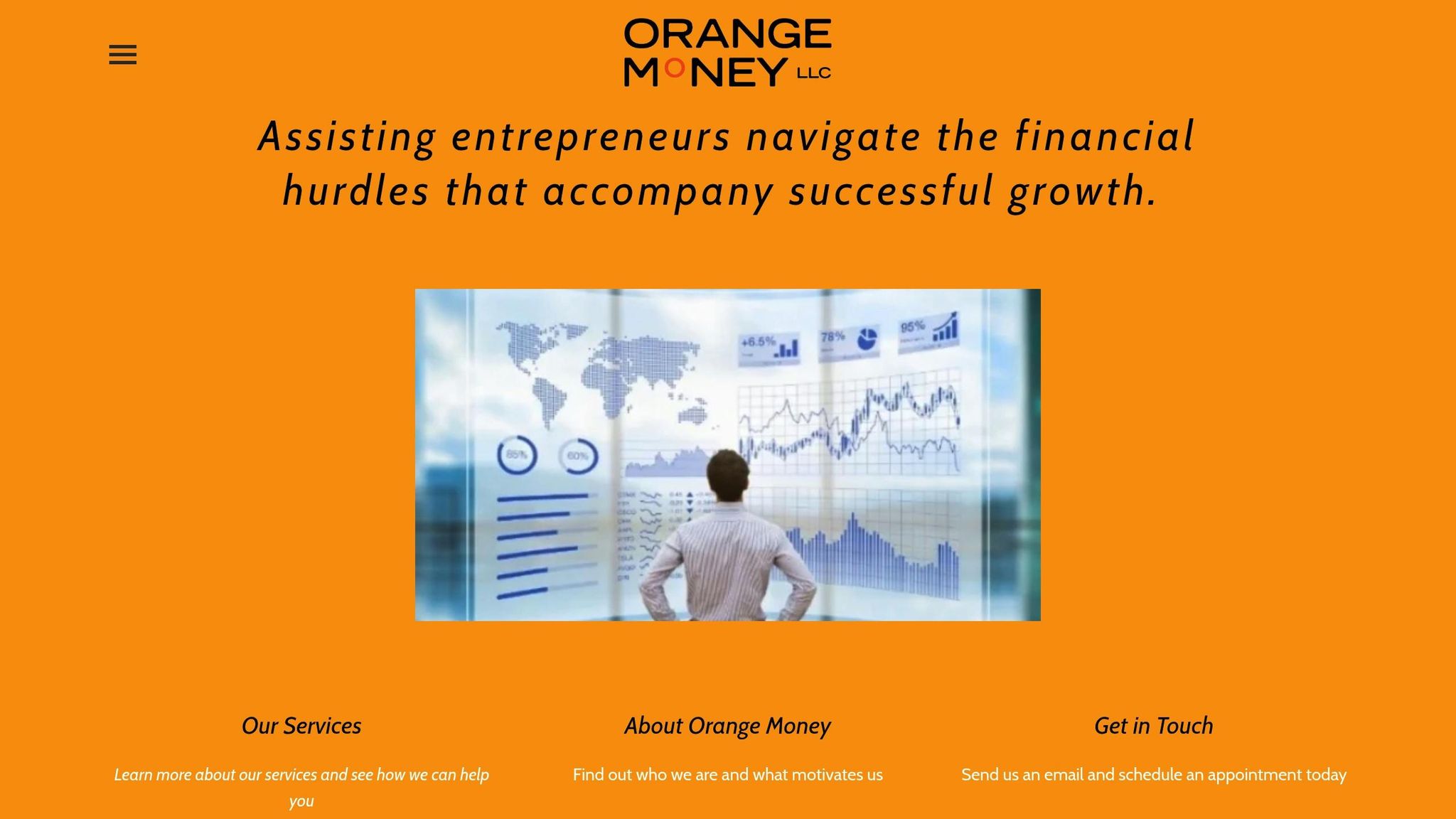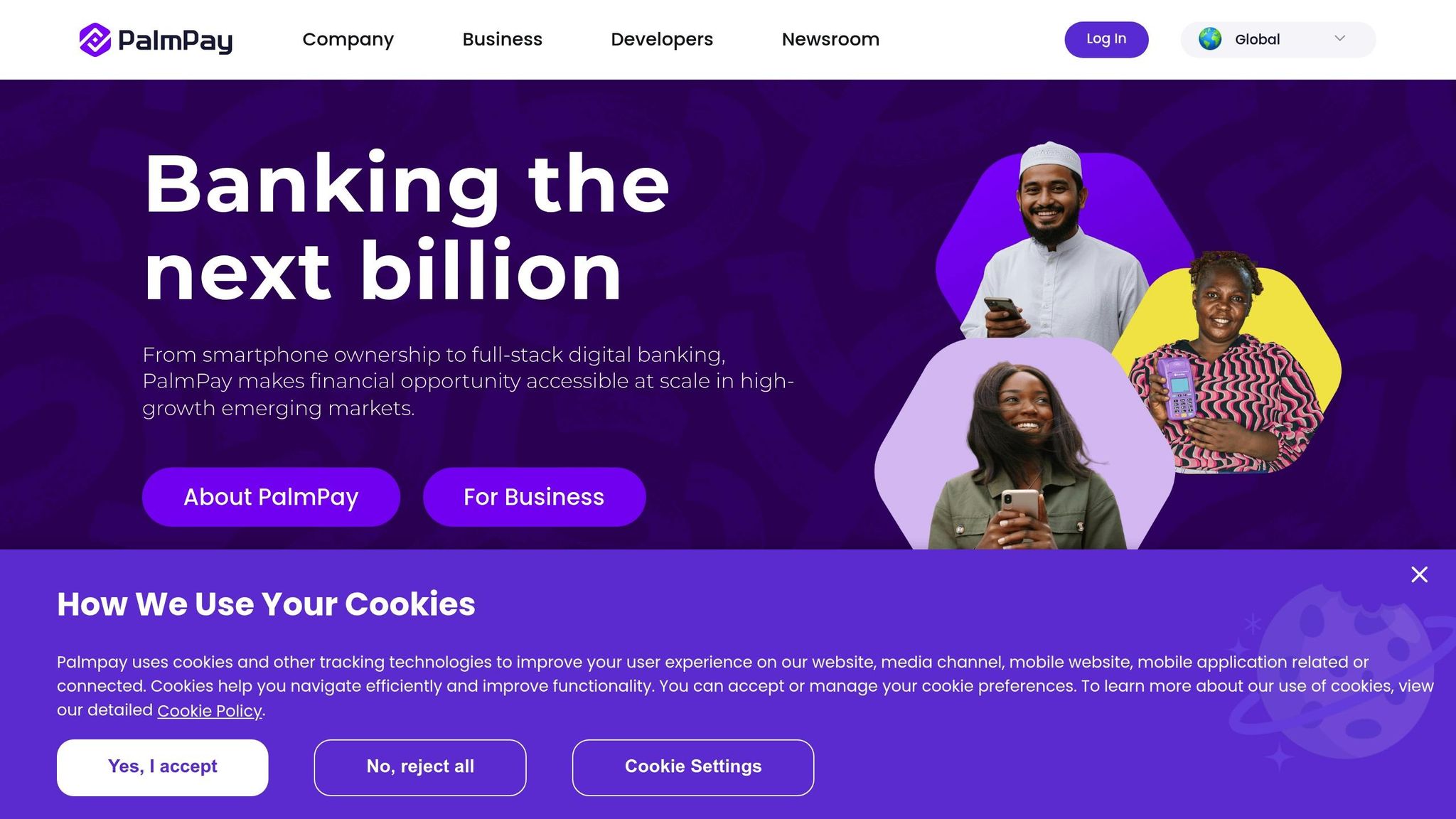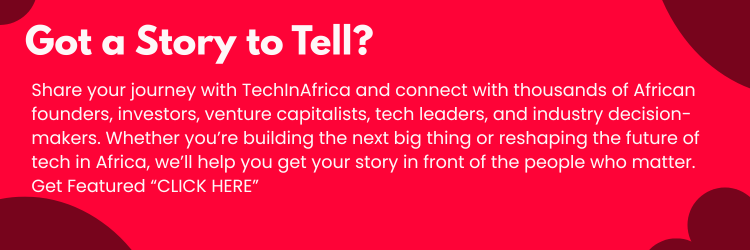Mobile money has transformed how people in Africa handle financial transactions, especially in regions with limited access to banking services. Sub-Saharan Africa now drives over 70% of global mobile money activity, with platforms like M-Pesa, MTN MoMo, and Orange Money leading the way. These services are critical for e-commerce, enabling secure payments, bridging rural and urban markets, and offering features like savings, loans, and bill payments.
Key Takeaways:
- M-Pesa: Dominates East Africa with 51+ million users and cross-border payment options.
- MTN MoMo: Operates in 16 countries with strong API integrations for businesses.
- Orange Money: Excels in cross-border remittances, serving 17 francophone nations.
- Airtel Money: Focuses on urban markets with digital wallets and merchant partnerships.
- VodaPay: South Africa’s super app, integrating financial tools with e-commerce.
- PalmPay: Popular in Nigeria for its user-friendly mobile wallet and instant transfers.
Mobile money is reshaping African marketplaces by addressing low banking penetration, improving transaction trust, and connecting underserved regions. With smartphone adoption rising and governments supporting digital finance, these platforms are set to grow further, powering Africa’s e-commerce future.
Mobile Money’s Continuous Role in Advancing Financial Access & Inclusion | #AFTSNBO24
Top Mobile Money Platforms in Africa
These platforms are at the heart of Africa’s growing e-commerce scene. The continent’s mobile money ecosystem is dominated by six major players, each bringing unique strengths to the table. These platforms have reshaped how people across Africa make payments, especially in areas where traditional banking systems fall short. Here’s a closer look at the key platforms driving digital commerce across the region.
M-Pesa
M-Pesa is the pioneer of mobile money in Africa. Launched in Kenya in 2007 by Safaricom, in partnership with Vodafone, it introduced SMS-based money transfers, setting the standard for mobile financial services. Today, M-Pesa operates in seven countries, including Tanzania, Mozambique, the Democratic Republic of the Congo, Lesotho, Ghana, and Egypt. It enables users to deposit and withdraw cash in areas with minimal banking infrastructure. For e-commerce, M-Pesa supports instant payments and cross-border transactions, processing billions of transactions annually. It remains one of the most trusted payment solutions in East Africa.
MTN Mobile Money (MoMo)

MTN Mobile Money (MoMo) capitalizes on MTN’s vast telecom network to operate in 16 countries across Africa. This platform is particularly appealing to businesses with pan-African goals. Its features include QR code payments, which make transactions easier for small businesses and informal traders. MoMo’s API integrations streamline payment processing, settlements, and even government payments. Partnerships with major e-commerce platforms further boost its transaction volumes.
Orange Money

Orange Money plays a major role in francophone Africa, operating in 17 countries across West and Central Africa. Its standout feature is its cross-border remittance capabilities, allowing users to send and receive money effortlessly. This makes it a go-to option for regional e-commerce and marketplaces serving diaspora communities. Orange Money is particularly well-suited to the unique needs of French-speaking regions.
Airtel Money
Airtel Money has grown by focusing on simplifying digital wallets, bill payments, and online shopping. Its seamless integration with e-commerce platforms allows for smooth payments and even refunds, catering to the needs of urban, tech-savvy users. In East Africa, Airtel Money’s focus on digital-first solutions, combined with its growing network of agents and merchant partnerships, has played a key role in boosting mobile money adoption.
VodaPay

VodaPay is tailored for South Africa’s digital commerce market. Launched by Vodacom in 2021, this super app – powered by Alipay technology – combines financial services, e-commerce, and business tools into one platform. Its integration with Vodacom‘s network provides scalability for businesses of all sizes, from small vendors to large enterprises. VodaPay positions itself as a one-stop solution for digital commerce in South Africa.
PalmPay

PalmPay has become a leading choice in Nigeria’s digital payment space. Known for its user-friendly setup and instant transfers, PalmPay offers a mobile wallet with features like airtime purchases, bill payments, and peer-to-peer transfers. As Nigerian businesses increasingly embrace digital operations, PalmPay’s smooth integration with e-commerce platforms makes it a favorite among mobile-first consumers.
Mobile Money Platform Comparison
When evaluating mobile money platforms, key factors to consider include coverage, user base, e-commerce integration, scalability, interoperability, transaction fees, and the strength of their agent networks.
Platform Comparison Table
| Platform | Coverage (Countries) | User Base (Millions) | E-Commerce Integration | Scalability | Interoperability | Transaction Fees | Agent Network Strength |
|---|---|---|---|---|---|---|---|
| M-Pesa | 7+ | 51+ | Strong (API, partners) | High | Moderate | Low-Medium | Extensive |
| MTN MoMo | 16 | 60+ | Good (MoMo Pay, APIs) | High | Improving | Low | Extensive |
| Orange Money | 17 | 50+ | Moderate | High | Strong (cross-border) | Medium | Strong |
| Airtel Money | 14+ | 30+ | Moderate | High | Moderate | Low | Good |
| VodaPay | 1 (South Africa, expanding) | 4+ | Very Strong (super app) | High | Limited | Low | Growing |
| PalmPay | 2+ | 10+ | Good | High | Limited | Low | Growing |
This table highlights the strengths and limitations of each platform in supporting African e-commerce. MTN MoMo leads with over 60 million users across 16 countries, while Orange Money operates in 17 nations, emphasizing its strong regional presence. M-Pesa’s impressive 51+ million users and its billions of transactions demonstrate its influence. Moreover, platforms like M-Pesa and MTN MoMo rely on extensive agent networks to enhance digital access in rural areas.
Platform Strengths and Weaknesses
Each platform offers unique features and faces specific challenges, shaping its role in digital payment ecosystems.
- M-Pesa stands out for its extensive agent network and SMS-based system, which makes it accessible in rural areas with low smartphone penetration. However, its moderate interoperability can limit cross-platform transactions.
- MTN MoMo benefits from its wide geographic coverage and improving cross-platform compatibility. Operating in 16 countries, it has established itself as a major player in the region.
- Orange Money excels in cross-border payment capabilities, making it ideal for regional marketplaces and diaspora remittances. However, its e-commerce integration tools are less advanced compared to some competitors.
- Airtel Money focuses on digital-first solutions and partnerships with e-commerce platforms. Its growing network of merchants is attractive for urban markets, but its smaller user base may limit its network effects.
- VodaPay leverages its super app approach, integrating financial services with shopping and business tools. Built on Alipay technology, it is designed for scalability and high transaction volumes. However, its reach is currently limited to South Africa, which restricts its broader impact.
- PalmPay offers a user-friendly interface tailored to Nigeria’s mobile-first market. Despite its appeal, limited interoperability and regional coverage may hinder its growth across Africa.
Low transaction fees remain a key driver of marketplace adoption. Platforms like M-Pesa and MTN MoMo, with their extensive agent networks, play a critical role in bridging the gap between cash and digital payments. These factors are essential for addressing scalability challenges and identifying opportunities for future growth.
sbb-itb-dd089af
Mobile Money Scaling Challenges and Opportunities
As mobile money platforms continue to grow in African e-commerce, they face a mix of hurdles and promising developments. While these platforms have shown impressive progress, challenges like regulatory inconsistencies and weak infrastructure still limit their ability to scale. On the brighter side, advancements in technology and policy are paving the way for growth.
Regulatory and Infrastructure Barriers
Inconsistent regulations across borders create significant obstacles for mobile money platforms trying to expand. For example, Kenya has thrived with a supportive regulatory framework that helped M-Pesa succeed, thanks to clear guidelines and government backing. But in many other countries, fragmented rules make it difficult for platforms to operate smoothly, whether across borders or even within their own markets.
The licensing process for new entrants is often slow and cumbersome, discouraging investment and slowing innovation in mobile money services. This regulatory uncertainty makes it tough for platforms to commit to long-term plans or justify the heavy investments needed for growth.
Another challenge is the limited reach of agent networks, particularly in rural areas where banking infrastructure is scarce. Agents play a critical role in providing cash-in and cash-out services, acting as the link between digital payments and physical cash. Without a strong agent presence, mobile money services remain out of reach for many users, especially in underserved regions.
Infrastructure issues like poor internet connectivity and frequent power outages further complicate matters. In areas outside major cities, unreliable electricity and inconsistent internet access disrupt transactions for both users and agents, making mobile money less dependable.
Low digital literacy is another barrier. Many potential users and merchants are hesitant to adopt mobile money due to a lack of familiarity with mobile apps or a general distrust of technology-based financial services. Addressing this requires significant investment in training and creating user-friendly designs. Merchants also need guidance on integrating mobile money into their businesses, adding another layer of complexity to scaling efforts.
Despite these challenges, new opportunities driven by technology and policy changes are creating a more favorable environment for mobile money platforms.
Growth Opportunities: Smartphones and Policy Support
Africa’s smartphone market has seen a 24% surge in early 2024, coupled with emerging government policies that are expanding mobile money’s potential. Smartphones enable platforms to offer advanced features like QR code payments and seamless e-commerce integration, which were not possible with basic feature phones.
Companies like M-Kopa are driving this trend by providing smartphones on flexible payment plans, broadening the base of users who can access mobile money services. As smartphones become more accessible, platforms can roll out more sophisticated features tailored to the needs of e-commerce marketplaces.
Government policies are also becoming more supportive. Recognizing the economic benefits of mobile money, many governments are simplifying licensing processes, offering incentives for expanding agent networks, and introducing digital ID systems to streamline user onboarding.
Some countries have even launched regulatory sandboxes – controlled environments where fintech companies can test innovative services without being burdened by full regulatory requirements. These initiatives encourage experimentation while maintaining oversight.
Cross-border payment solutions are another area of progress. Platforms like Orange Money and Minka are developing systems for seamless international transactions, reducing both costs and delays. This is especially important for e-commerce platforms that serve customers and merchants across multiple countries.
The investment landscape reflects the growing optimism around mobile money. In 2024, fintech startups accounted for nearly half of all startup investments in Africa. This influx of funding is helping mobile money platforms tackle infrastructure challenges and expand their services.
Currently, Sub-Saharan Africa leads the world in mobile money transactions, accounting for over 70% of global activity in this space. With e-payments projected to grow by 20% annually and reach $40 billion by 2025, the potential for mobile money platforms is enormous. However, with only 5-7% of transactions currently digital, there’s still a vast untapped market to explore.
Efforts like interoperability reforms and expanding agent networks are driving adoption, especially in West and East Africa, where regulatory coordination is improving. These advancements are laying the groundwork for mobile money platforms to scale effectively and meet the growing demands of African e-commerce.
The Future of Mobile Money in African Marketplaces
Mobile money platforms are set to become the backbone of Africa’s digital economy, with their influence growing as technology advances and regulations adapt. The trends point to deeper integration and expansion in the coming years.
By March 31, 2025, Kenya recorded an impressive 45.4 million mobile money users – a 7.3% growth, representing 86.6% penetration of the population. Ghana followed suit, with registered mobile money accounts increasing from 66.9 million to 74.1 million in early 2025. Across Africa, there were 178 active mobile money services in 2024, supporting nearly 280 million monthly active accounts.
This success has drawn the attention of major financial players. Companies like Mastercard and Visa are heavily investing in Africa’s mobile money sector, reflecting their confidence in its potential. Visa’s 2022 partnership with Safaricom, which enabled international transactions through M-Pesa, is a clear example of this commitment. It also highlights the growing global integration of Africa’s mobile money systems.
The rising adoption of smartphones is another game-changer. It opens the door for advanced features like QR code payments, seamless e-commerce integration, and improved security measures – capabilities that are quickly becoming essential for users.
Platforms that prioritize interoperable systems and partnerships with financial institutions can tap into larger markets and build trust among users. By catering to the vast mobile money user base, these platforms can enhance user experiences and drive transaction volumes.
Regulatory changes are also steering growth in the right direction. Governments across Africa are increasingly recognizing the economic benefits of mobile money, from boosting tax revenues to improving financial inclusion. This recognition is paving the way for more supportive policies, simplified licensing processes, and initiatives that promote cross-border payment solutions.
Mobile money is poised to become an even more integral part of daily life in Africa. With the combination of growing smartphone usage, favorable regulations, and increased investor interest, these platforms are reshaping how Africans transact, shop, and manage their finances. The question now is not whether mobile money will dominate African marketplaces – but how quickly it will happen and which platforms will lead the charge.
FAQs
How do mobile money platforms like M-Pesa and MTN MoMo protect financial transactions in areas with limited banking services?
Mobile money platforms like M-Pesa and MTN MoMo take multiple steps to protect financial transactions, especially in areas where traditional banking services are limited. For starters, they rely on encrypted communication channels to keep sensitive information – like personal and financial data – safe during transfers.
On top of that, these platforms use two-factor authentication (2FA) and PIN-based security to confirm user identities and block unauthorized access. Many also keep an eye on transactions in real time, quickly identifying and stopping any suspicious activity to add an extra layer of protection for users.
What obstacles do mobile money platforms face when expanding across African countries, and how are they addressing these challenges?
Mobile money platforms in Africa face a variety of hurdles when trying to expand into new markets. These challenges include differences in regulations, infrastructure gaps, and varying levels of financial literacy. Each country has its own set of rules governing financial services, which can make cross-border operations slower and more complex. On top of that, rural areas often lack reliable internet and mobile network coverage, making it harder for people to adopt these services.
To address these issues, many platforms collaborate with local governments to navigate regulatory requirements and build trust within communities. They also invest in improving infrastructure by teaming up with telecom providers to enhance connectivity. Additionally, some platforms prioritize creating user-friendly interfaces and run educational campaigns aimed at boosting financial literacy, helping more people feel confident using their services.
How is growing smartphone use influencing mobile money platforms in Africa?
The growing use of smartphones across Africa is reshaping mobile money platforms, opening the door to more advanced tools and services. With improved internet access, these platforms now offer features like e-commerce integration, instant peer-to-peer transfers, and digital wallets that serve both individuals and businesses.
Smartphones have also made it possible for mobile money providers to develop intuitive apps with added security measures, such as biometric authentication, and real-time tracking of transactions. These advancements are helping mobile money systems adapt to the changing demands of African markets, making them more flexible and capable of handling increasing usage.






